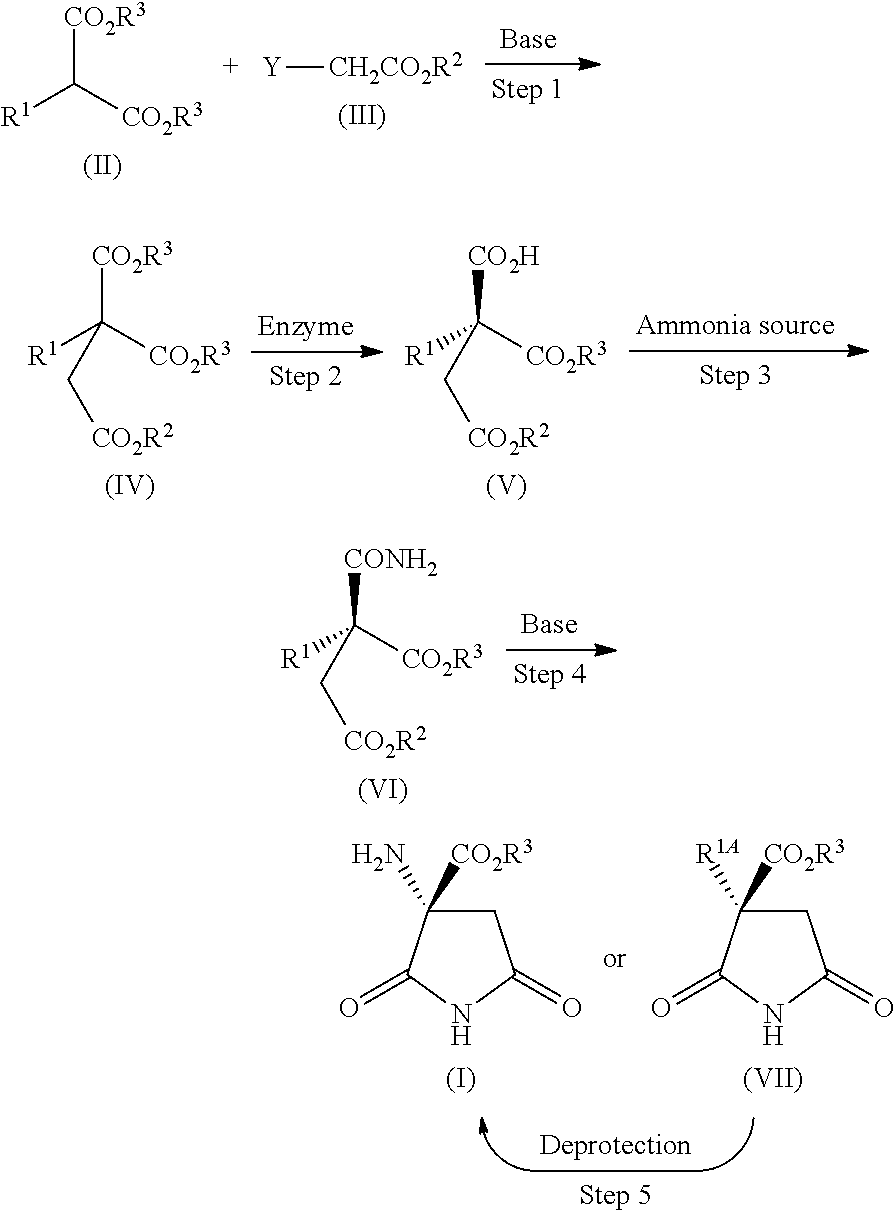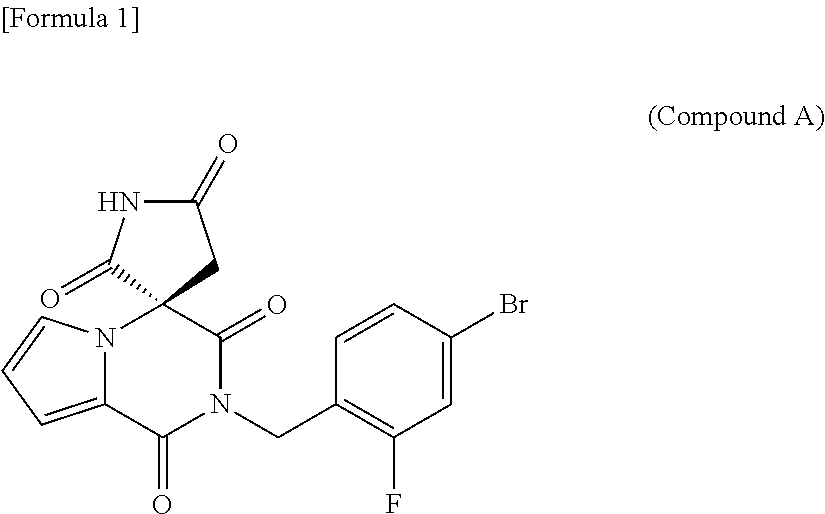Process for producing optically active succinimide derivatives and intermediates thereof
- Summary
- Abstract
- Description
- Claims
- Application Information
AI Technical Summary
Benefits of technology
Problems solved by technology
Method used
Image
Examples
example 1
Production of Diethyl 2-benzyloxycarbonylamino-2-ethoxycarbonylsuccinate (Ethyl Chloroacetate Method)
[0082]A suspension of diethyl 2-benzyloxycarbonylaminomalonate (5.0 g), potassium carbonate (2.7 g), potassium iodide (0.27 g), and ethyl 2-chloroacetate (2.6 g) in DMF (50 mL) was stirred at 50° C. for 1 hour. The reaction mixture was cooled, and then poured into diluted hydrochloric acid, the mixture was extracted with ethyl acetate, and the extract was washed with saturated brine, and then dried over anhydrous magnesium sulfate. The solvent was evaporated under reduced pressure, and the residue was crystallized from ethyl acetate / n-hexane to obtain the title compound (5.5 g, yield: 86%) as colorless crystals.
[0083]1H NMR (CDCl3) δ (ppm): 7.34 (5H, m), 6.39 (1H, s), 5.10 (2H, s), 4.24 (4H, q, J=6.9 Hz), 4.10 (2H, q, J=7.2 Hz), 3.49 (2H, s), 1.21 (9H, m) MS (FAB): m / z 396 (M+H+)
[0084]HR-MS (FAB): calcd for C19H26NO8 396.1658, found 396.1653 (M+H+)
example 2
Production of Diethyl 2-benzyloxycarbonylamino-2-ethoxycarbonylsuccinate (Ethyl Bromoacetate Method)
[0085]A solution of diethyl 2-benzyloxycarbonylaminomalonate (50 g) in anhydrous DMF (300 mL) was added portionwise with sodium hydride (60%, 6.47 g) with ice cooling and stirring, then the mixture was stirred at room temperature for 30 minutes, and subsequently added with ethyl 2-bromoacetate (22.6 g), and the mixture was stirred overnight. The reaction mixture was poured into diluted hydrochloric acid, the mixture was extracted with ethyl acetate, and the extract was washed with saturated brine, and then dried over anhydrous magnesium sulfate. The solvent was evaporated under reduced pressure, and the residue was subjected to silica gel column chromatography, in which elution was performed with n-hexane / ethyl acetate (5:1) for purification, and then crystallized from ethyl acetate / n-hexane to obtain the title compound (46.7 g, yield: 83%) as colorless crystals.
example 3
Production of (R)-1-ethyl hydrogen 3-benzyloxycarbonylamino-3-ethoxycarbonylsuccinate (Hydrolysis with Pig Liver Esterase)
[0086]4.0 g of pig liver esterase produced by Sigma [PLE (27 kU / g), lyophilized product, product number: E30191 was dissolved in a 0.05 mol / L phosphate buffer adjusted to pH 6.5 (360 mL), and the solution was added with a solution of diethyl 2-benzyloxycarbonylamino-2-ethoxycarbonylsuccinate (4.0 g) dissolved in ethanol (40 mL). The mixture was stirred at 30° C. for 20 hours to obtain (R)-1-ethyl hydrogen 3-benzyloxycarbonylamino-3-ethoxycarbonylsuccinate at a yield of 84% and optical purity of 93.6% ee.
[0087]After completion of the reaction, the reaction mixture was filtered by using a filtration aid (KC Floc 100) to remove the insoluble matter. The filtrate was cooled, and adjusted to pH 2 by adding 6 mol / L hydrochloric acid, then the objective substance was extracted with ethyl acetate, and the extract was washed with saturated brine, and dried over anhydrous ...
PUM
| Property | Measurement | Unit |
|---|---|---|
| Optical activity | aaaaa | aaaaa |
Abstract
Description
Claims
Application Information
 Login to View More
Login to View More - R&D
- Intellectual Property
- Life Sciences
- Materials
- Tech Scout
- Unparalleled Data Quality
- Higher Quality Content
- 60% Fewer Hallucinations
Browse by: Latest US Patents, China's latest patents, Technical Efficacy Thesaurus, Application Domain, Technology Topic, Popular Technical Reports.
© 2025 PatSnap. All rights reserved.Legal|Privacy policy|Modern Slavery Act Transparency Statement|Sitemap|About US| Contact US: help@patsnap.com



